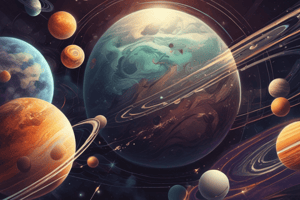Podcast
Questions and Answers
The Earth's surface is made up of land (29%) and ______ (71%)
The Earth's surface is made up of land (29%) and ______ (71%)
water
The Earth is surrounded by ______
The Earth is surrounded by ______
air
Water from melting snow and ice also flows into ______
Water from melting snow and ice also flows into ______
rivers
The centre of the Earth is still extremely ______
The centre of the Earth is still extremely ______
The Earth's natural resources include water, wind, sol, and ______
The Earth's natural resources include water, wind, sol, and ______
Rain falls and rivers or soaks into the ground to join ______
Rain falls and rivers or soaks into the ground to join ______
All rocks on the surface of Earth get broken down to pebbles, gravel, and ______
All rocks on the surface of Earth get broken down to pebbles, gravel, and ______
When rocks are weathered, they break down into smaller particles like pebbles, gravel, and ______
When rocks are weathered, they break down into smaller particles like pebbles, gravel, and ______
The process of rock breakdown results in the formation of pebbles, gravel, and ______
The process of rock breakdown results in the formation of pebbles, gravel, and ______
Over time, rocks undergo weathering to form pebbles, gravel, and ______
Over time, rocks undergo weathering to form pebbles, gravel, and ______
As rocks erode, they transform into smaller materials such as pebbles, gravel, and ______
As rocks erode, they transform into smaller materials such as pebbles, gravel, and ______
It is then deposited on the banks of the ______. Rivers carry these small pieces and deposit them as sediment. Sometimes change can be sudden.
It is then deposited on the banks of the ______. Rivers carry these small pieces and deposit them as sediment. Sometimes change can be sudden.
Water from melting snow and ice also flows into ______
Water from melting snow and ice also flows into ______
The Earth's natural resources include water, wind, sol, and ______
The Earth's natural resources include water, wind, sol, and ______
Rain falls and rivers or soaks into the ground to join ______
Rain falls and rivers or soaks into the ground to join ______
The Earth's surface is made up of land (29%) and ______ (71%)
The Earth's surface is made up of land (29%) and ______ (71%)
Over a period of time, the pieces become smaller and turn into ______, mud, and soil.
Over a period of time, the pieces become smaller and turn into ______, mud, and soil.
The rivers carry this soil with them. The rivers carry this ______ with them.
The rivers carry this soil with them. The rivers carry this ______ with them.
Rain falls and rivers or soaks into the ground to join ______.
Rain falls and rivers or soaks into the ground to join ______.
Water from melting snow and ice also flows into ______.
Water from melting snow and ice also flows into ______.
The Earth's natural resources include water, wind, sol, and ______.
The Earth's natural resources include water, wind, sol, and ______.
During heavy rain, rivers and lakes can ______ the land
During heavy rain, rivers and lakes can ______ the land
The water level in rivers and lakes rises when there is heavy ______
The water level in rivers and lakes rises when there is heavy ______
Water from melting snow and ice can also ______ the rivers
Water from melting snow and ice can also ______ the rivers
The Earth's surface is composed of land and ______
The Earth's surface is composed of land and ______
The Earth's natural resources include wind, soil, and ______
The Earth's natural resources include wind, soil, and ______
When dams burst, and crops in the fields, villages, and even whole cities can become flooded with water, it is an example of ______
When dams burst, and crops in the fields, villages, and even whole cities can become flooded with water, it is an example of ______
______ occurs when water overflows and covers areas that are usually dry
______ occurs when water overflows and covers areas that are usually dry
Heavy rain can lead to ______, causing damage to infrastructure and agriculture
Heavy rain can lead to ______, causing damage to infrastructure and agriculture
The process of rocks breaking down into smaller particles like pebbles and gravel is called ______
The process of rocks breaking down into smaller particles like pebbles and gravel is called ______
______ is the process by which rocks are broken down into smaller fragments over time
______ is the process by which rocks are broken down into smaller fragments over time
Flashcards are hidden until you start studying




